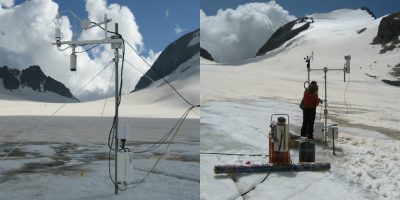Ablation, a question of energy
PDF
A glacier is an open system that exchanges mass and energy with its environment. The ablation, or loss of mass on the surface, results from the energy available on the surface, whose exchanges with the atmosphere can be written in the form of a fairly simple equation, by writing that the energy consumed by the glacier is equal to the energy supplied:
M + G = S↓ – S↑ + L↑ – L↑ + H + LE + P (W/m2)
Consumption :
M the energy consumed by the cast iron;
G the energy used to heat the snowpack or glacier to the melting temperature.
Contributions :
S↓ the energy of incident solar radiation (short wavelengths); S↑ is the energy of solar radiation reflected from the surface, also equal to S↓.α, with α the albedo of the surface, i.e. the percentage of energy reflected from the surface in short wavelengths (visible light from the Sun).
L↓ and L↑ are the energies of infrared thermal radiation (long wavelengths) from the atmosphere (L↓) and emitted from the surface (L↑), read “the thermal radiation of the black body”.
H the sensitive heat flux, related to air turbulence, and therefore to the wind and temperature gradient between the surface and the near atmosphere;
LE the latent heat flux, related to the processes of melting, condensation, evaporation or sublimation (changes in solid, liquid, vapour phases). This flow removes a lot of energy from the surface if it is sublimation, or on the contrary gives it a lot of energy if it is condensation. This heat flux is often opposite to that of sensible heat, H. Sublimation requires 8.5 times more energy (2,834,000 Joules per kg) than fusion (334,000 Joules per kg).
P is the energy flow provided by precipitation, which is generally negligible.
A key element in surface melting is surface albedo. When, in the middle of the summer season, the winter snowpack disappears from the ablation zone, the glacier surface reveals ice that has a much lower albedo than snow (typically 0.3 instead of 0.8 for fresh snow): the reflected radiative energy (S↓.α) then decreases sharply, which favours melting. On the contrary, summer snowfalls can considerably slow melting.




